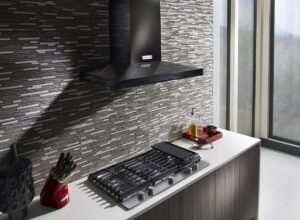The Function of Ventilation Hoods
Ventilation hoods, often found in kitchens both residential and commercial, are designed to maintain air quality and safety.
Air Extraction
The primary function of a ventilation hood is air extraction. When cooking, heat, smoke, and airborne particles such as grease and steam are produced. These can create an uncomfortable environment and pose a fire risk. The ventilation hood works by drawing in this polluted air through a fan mechanism. This process is known as extraction.
Removal of Heat and Smoke
One of the key roles of the ventilation hood is the removal of heat and smoke. By extracting the air above the cooktop, the hood helps to lower the overall temperature of the kitchen. This not only makes the kitchen more comfortable but also reduces the risk of heat-related accidents.
Role of Filters
Filters play a crucial role in the operation of ventilation hoods. As the polluted air is drawn up into the hood, it passes through filters which trap grease and other particles. There are different types of filters used in ventilation hoods, including aluminum, stainless steel, and charcoal filters.
Aluminum and stainless-steel filters are used to trap grease particles. These filters are typically dishwasher safe, making them easy to clean and maintain. On the other hand, charcoal filters are used in recirculating hoods to remove odors from the air before it is recirculated back into the kitchen.
Ventilation Hoods and Fire Safety
The role of ventilation hoods in fire safety is significant and multifaceted.
Prevention of Flammable Residue Accumulation
One of the primary ways ventilation hoods contribute to fire safety is by preventing the accumulation of flammable residues. When cooking, especially frying or grilling, grease particles become airborne and can accumulate on surfaces over time. These residues are flammable and can ignite if they come into contact with a high heat source.
Ventilation hoods, with the air extraction and filtration systems, effectively capture these particles, reducing their accumulation on kitchen surfaces. By doing so, they significantly lower the risk of a grease fire, which can be extremely dangerous and spread quickly.
Reduction of Fire Risk
Apart from grease, cooking also produces heat and smoke, both of which can contribute to the risk of fire. Excessive heat can cause nearby items to combust, while smoke can obscure vision and make it difficult to respond effectively in the event of a fire.
By extracting heat and smoke, ventilation hoods help maintain a safer kitchen environment. They keep the temperature at a safe level and ensure clear visibility, enabling quicker response times if a fire does break out.
Maintenance for Safety
Maintaining the safety and efficiency of your ventilation hood requires regular maintenance and cleaning. This not only ensures the longevity of the appliance but also significantly reduces the risk of fire. Here’s a more detailed look at the importance of maintenance and some tips to keep your ventilation hood in top shape.
Importance of Regular Maintenance
Regular maintenance of your ventilation hood is crucial for several reasons. Firstly, it ensures that the hood is functioning at its best, effectively removing heat, smoke, and airborne particles from your kitchen. Secondly, it prevents the buildup of grease and other flammable residues, thereby reducing the risk of fire. Lastly, regular maintenance can help identify potential issues early, allowing for timely repairs and preventing costly replacements.
Cleaning Your Ventilation Hood
Cleaning is a key aspect of ventilation hood maintenance. Over time, grease and other particles can accumulate on the filters and internal surfaces of the hood. If not cleaned regularly, this buildup can reduce the efficiency of the hood and increase the risk of fire.
Here are some steps for cleaning your ventilation hood:
- Turn off the hood and unplug it: Always ensure the hood is turned off and unplugged before cleaning to prevent electrical shocks.
- Remove the filters: Most ventilation hoods have removable filters. Carefully remove these and set them aside for cleaning.
- Clean the filters: Soak the filters in a solution of warm water and dish soap. After soaking, scrub the filters gently with a soft brush to remove any stubborn grease. Rinse thoroughly and allow them to dry completely before reinstallation.
- Clean the hood: Wipe down the interior and exterior of the hood with a damp cloth and a mild detergent. Be sure to reach all corners and crevices. Avoid using abrasive cleaners or scrubbers as they can scratch the surface.
- Reinstall the filters: Once the filters are completely dry, reinstall them in the hood.
Remember to refer to your ventilation hood’s user manual for specific cleaning instructions, as some models may require special care.
Signs Your Ventilation Hood May Need Attention
Regular inspections can help identify signs that your ventilation hood may need maintenance or repairs. Here are some signs to look out for:
- Reduced extraction: If your hood seems to be extracting less air than usual, it may be a sign that the filters are clogged or the motor is failing.
- Unusual noises: Strange noises during operation could indicate a problem with the fan or motor.
- Persistent odors: If cooking odors linger in your kitchen even after using the hood, it may not be functioning properly.
- Visible grease buildup: If you notice a greasy residue on the hood or filters, it’s time for a thorough cleaning.
Ventilation hoods play a pivotal role in maintaining fire safety in both residential and commercial kitchens. Regular maintenance and cleaning of the hoods are crucial to ensure the effectiveness and longevity. By understanding the function and importance, we can appreciate the unsung heroes of fire safety and ensure a safer cooking environment. Remember, a well-maintained ventilation hood is not just an appliance, but a vital part of your kitchen’s fire safety system.
Seek a professional help should you need a maintenance service or repair your ventilation hood.
